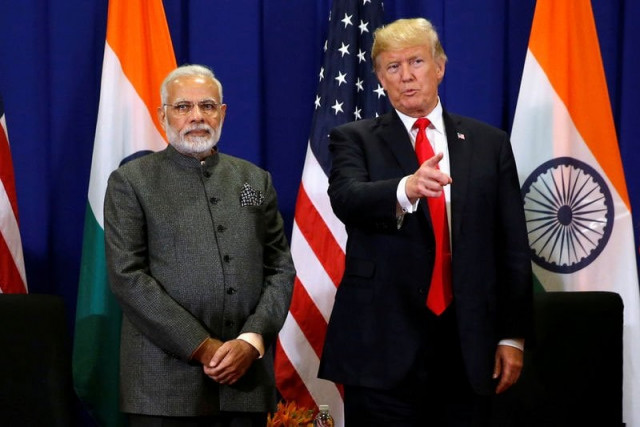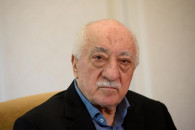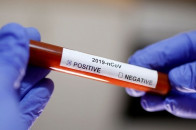Trump in India: meaning for Pakistan
Trump complimented Modi in his thinking about religious freedom.

US President Donald Trump holds a bilateral meeting with India's Prime Minister Narendra Modi alongside the ASEAN Summit in Manila, Philippines November 13, 2017. PHOTO: REUTERS
Modi delivered what Trump likes – large adoring crowds. Before departure from Washington by Air Force One, the presidential plane, he told reporters traveling with him that Prime Minisiter Modi had promised the he would be greeted by “the biggest event they have ever had in India”. Tens of thousands of people lined up on the route from the airport to the cricket stadium that, when fully constructed, will hold 110,000 viewers. However, in one of the newspaper stories covering the event, it was pointed out that the rally was likely not even the biggest Indian turnout for an American president: Dwight D Eisenhower drew a crowd of one million during a 1959 visit to New Delhi, according to an Associated Press report at the time.
According to one account of the Trump visit, the American President has shown “little concern for actions by Mr. Modi that have drawn international condemnation, including abruptly revoking the statehood of predominantly Muslim Kashmir and backing a law establishing a religious test for the new migrants that critics call evidence of plans to turn India into a Hindu-centric state whose 200 million Muslims would be second-class citizens”. These moves probably pleased Trump since he did not hide his dislike for Muslims and Islam, their faith. The first act by him when he moved into the White House was to issue an executive order banning entry into the US of citizens from seven Muslim majority countries in the world.
Sectarian-themed clashes erupted in New Delhi as Trump attended the rally at Ahmadabad, Gujarat. People for and against Modi’s new immigration law fought in the streets of the Indian capital, leaving 42 dead. A policeman was killed amid rising tensions between Hindus and Muslims in the city. “The Muslims have other countries they can go to, like Syria and Nigeria. They need to get out of India,” said a participant of the New Delhi riots.
Pakistan was not far from the minds of the crowd that turned up to see and hear Trump. He drew the day’s loudest cheers when he mentioned India’s rival and neighbour Pakistan, saying that he was working with that country “to crack down on the terrorist organizations” along its border with India. “Every nation has the right to secure and controlled borders. The United States and India are committed to working together to stop terrorists and to fight their ideology,” he told the cheering crowd. This was the Indian story all along which Trump had bought. According to the Modi administration, the trouble in the India-Occupied Kashmir was caused by infiltrators sent in by Pakistan to cause trouble. There was, of course, no mention of the heavy-handed way, including the torture of thousands of people who were protesting the way the government headed by Modi was handling the crisis it had created in the Muslim-majority Kashmir.
Trump referred to the large Indian presence in his country. He put their number at four million and said that he was impressed with the economic role the American-Indians were playing in the US. The American President is popular in India. A 2019 poll by the Washington-based Pew Research Center found 56% of Indian citizens expressing confidence in him to handle world affairs. India was one of the just half a dozen countries that had a majority expressing that view.
The Ahmadabad rally was described by some American journalists as the “second act of budding friendship between the two men, Trump and Modi, leaders of the world’s most populous democracies. Last year, Mr. Trump and Mr. Modi shared a stage in Houston at a rally called ‘Howdy, Modi!’ This one is called ‘Namaste Trump’ which translates roughly as ‘Hello Trump’,” wrote one newspaper.
While looking forward to an exceptionally warm welcome, Trump had hoped that he would be able to get India to agree to a major trade deal. He was hoping to sign it during his visit. That did not happen as the Indian officials were not prepared to concede to Washington’s demands for better access to its technology firms in the large and rapidly growing Indian markets and protection of intellectual property developed by the firms once they started operating in the country. The Americans also wanted India to allow greater import of food and agricultural products into their country from the US. These demands were not different from those the Americans were making on China.
Will America under Trump turn a blind eye to the fact that Modi’s India was abandoning what some prominent Indian scholars had called the “idea of India”? This was the belief that India had found a way of satisfying most segments of its very diverse population. It had built inclusive political, social and economic protections into its Constitution. Modi and his associates, who have their roots in the Hindu extremist organisation known by its acronym as RSS, are rapidly abandoning that system. They are moving towards Hindutva, a strong belief that India is only for Hindus. This will relegate 200 millions of its Muslim population to be second-class citizens. “There are more questions in the last six months about India’s commitment to democracy, than we have really seen in the history of the US-Indian relationship,” commented Bruce Riedel of the Brookings Institution who had once worked at the CIA and watched political developments across the globe. But he added that, “the good news for India is that the last person in the world likely to raise any of these issues is Donald Trump”.
Trump complimented Modi in his thinking about religious freedom. “We did talk about religious freedom, and I will say that the Prime Minister was incredible on what he told me,” he told the joint press conference with Modi standing by his side. “He wants people to have religious freedom, and very strongly.” Then, in his continuing murder of the English language, he spoke warmly about the way relations between the two countries were developing while he was in charge. “We think we are at a point where our relationship is so special with India, it has never been as good as it is now. We feel very strongly about each other, and we have done something that is very unique,” said the American in his usual inarticulate way.
Published in The Express Tribune, March 2nd, 2020.
Like Opinion & Editorial on Facebook, follow @ETOpEd on Twitter to receive all updates on all our daily pieces.



















COMMENTS
Comments are moderated and generally will be posted if they are on-topic and not abusive.
For more information, please see our Comments FAQ